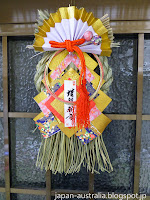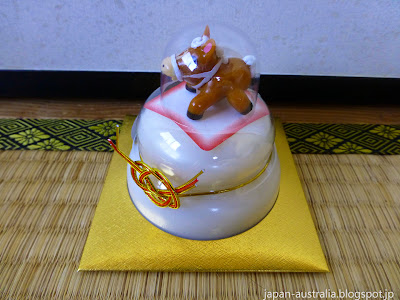January 1st or New Year’s Day (元日) is a very fortunate day in Japan. It is meant to be full of joy and happiness with no stress or anxiety. Everything should be clean, and you should not work on this day. A popular custom is to watch the first sunrise of the new year (初日), which is meant to guarantee good luck for the new year. It is tradition to visit a shrine or temple during oshogatsu for hatsumode (初詣), the first visit of the new year. The bigger more popular shrines and temples are extremely crowded with people praying for health and happiness. We usually visit Inaba Jinja, which is the biggest and most famous shrine in Gifu City.
Here are some popular traditions and customs that are followed during New Year’s in Japan
Shimekazari
Shimekazari (しめ飾り) is a traditional Japanese New Year’s decoration usually hung on the front door or over entryways. They are designed to keep bad spirits away as well as inviting the Toshigami (歳神) or Shinto deity to visit. They are made out of sacred Shinto rice straw rope, pine twigs and carefully crafted zigzag-shaped paper strips called shide.
• The straw has the meaning of inviting the Toshigami to remain in the house.
• The opened fan signifies the wish for a prosperous future.
• The stalks of rice express the hope for a good harvest in the new year.
• The zigzag-shaped paper strips have the purpose of driving away evil spirits.
Unlike Christmas decorations that are re-used every year, charms and good luck tokens in Japan must be new as they symbolize a brand-new start and a move away from the past. This means that it is tradition to buy a new one every year and dispose of them via a ritual fire on January 15th at your local shrine.
Kadomatsu (門松) is a traditional Japanese decoration made for the new year period in Japan. These bamboo and pine decorations are placed in pairs in front of homes or businesses to welcome ancestral spirits or kami (Shinto spirits) who visit during New Year’s Day. They are believed to bring prosperity and good luck for the family.
 |
| One of my recent Shimekazari |
 |
| An older Shimekazari from 2013/2014 |
Kadomatsu
Kadomatsu (門松) is a traditional Japanese decoration made for the new year period in Japan. These bamboo and pine decorations are placed in pairs in front of homes or businesses to welcome ancestral spirits or kami (Shinto spirits) who visit during New Year’s Day. They are believed to bring prosperity and good luck for the family.
The bamboo symbolizes strength and prosperity, the pine symbolizes long life, and the rope protects against evil spirits. The three pieces of bamboo usually stand at different heights with the tallest representing heaven, the middle one humanity, and the shortest one earth. Some kadomatsu like in my picture below place the earth and humanity bamboo at equal heights.
After January 7th or 15th (depending on what part of Japan you are in), the kadomatsu is burned at the shrine in a special ceremony to appease the kami or Toshigami and release them.
Kagami Mochi (鏡餅) is another traditional New Year’s decoration that is equally important as shimekazari and kadomatsu. It consists of two round mochi (Japanese rice cakes) of differing sizes. The smaller one is placed on top of the larger one with a daidai (bitter orange) on top. The two mochi represent the past year and the year ahead with the daidai, which means “generations” in Japanese representing the continuation of a family from one generation to the next. We usually place the kagami mochi in the genkan (entryway) to bring good luck and fortune. These days you can buy a modern version with the zodiac sign for the coming year on top instead of the bitter orange. 2024 will be the year of the dragon.
Mochibana (餅花) is a popular New Year’s decoration that consists of branches decorated with pieces of white and pink mochi. They look like flowering branches of the blossoms in spring and signal the coming of spring ahead in Japan.
Nengajo (年賀状) is a Japanese custom of sending a New Year’s Day Card to friends and relatives. It is very similar to our custom of sending Christmas Cards. Japanese people send these so that they arrive on January 1st. It is common to feature the zodiac sign for the coming year on the card.
Toshikoshi Soba (年越しそば) is buckwheat noodles that are eaten on New Year’s Eve and symbolise longevity. It is believed that by eating these long thin noodles you will live a long and healthy life. Toshikoshi means the ending of the old year, and the beginning of the new one. It has become a modern tradition to eat toshikoshi soba while watching TV on New Year’s Eve, with the music competition Kohaku Uta Gassen (紅白歌合戦) the most popular show to watch. To ensure good luck, all the noodles must be polished off before midnight.
Hatsumode (初詣) is the first shrine visit of the new year to pray for health, happiness and prosperity for the coming year. Most people will make their visit on the first, second, or third day of the year. A common custom is to buy an omikuji, which is a fortune written on a small piece of paper. If the omikuji predicts bad luck, you can tie it onto a tree on the shrine grounds, in order for the prediction not to come true.
Osechi Ryori (御節料理) is traditional Japanese dishes served during New Year celebrations. The tradition started in the Heian Period (794-1185) with each dish having a special meaning. Osechi ryori is served in special boxes called jubako (重箱) and contain food such as konbu (boiled seaweed), kamaboko (fish cakes), kinpira gobo (burdock root), and my personal favourite kuromame (sweetened black beans).
Ozoni (お雑煮) is a soup made with mochi (rice cakes) traditionally served on New Year’s Day. Our family usually has ozoni for breakfast on New Year’s Day. Ozoni varies from region to region and from household to household.
Otoshidama (お年玉) is special money given to children on New Year’s Day. It is handed out in small, decorated envelopes by family and relatives. The amount varies depending on the age of the child but will typically be something like this.
Mochi (餅) are soft rice cakes that are enjoyed during the New Year period in Japan. A favourite custom for New Year's is creating mochi from boiled sticky rice. This is called mochitsuki (餅つき) and is usually made before New Year’s Day and eaten during the start of New Year’s in January.
Hope you have a great New Year's wherever you are in the world!
 |
| Kadomatsu in Gifu City |
Kagami Mochi
Kagami Mochi (鏡餅) is another traditional New Year’s decoration that is equally important as shimekazari and kadomatsu. It consists of two round mochi (Japanese rice cakes) of differing sizes. The smaller one is placed on top of the larger one with a daidai (bitter orange) on top. The two mochi represent the past year and the year ahead with the daidai, which means “generations” in Japanese representing the continuation of a family from one generation to the next. We usually place the kagami mochi in the genkan (entryway) to bring good luck and fortune. These days you can buy a modern version with the zodiac sign for the coming year on top instead of the bitter orange. 2024 will be the year of the dragon.
 |
| Traditional style Kagami Mochi |
 |
| A modern version with the zodiac sign |
Mochibana
Mochibana (餅花) is a popular New Year’s decoration that consists of branches decorated with pieces of white and pink mochi. They look like flowering branches of the blossoms in spring and signal the coming of spring ahead in Japan.
Nengajo
Nengajo (年賀状) is a Japanese custom of sending a New Year’s Day Card to friends and relatives. It is very similar to our custom of sending Christmas Cards. Japanese people send these so that they arrive on January 1st. It is common to feature the zodiac sign for the coming year on the card.
Toshikoshi Soba
Toshikoshi Soba (年越しそば) is buckwheat noodles that are eaten on New Year’s Eve and symbolise longevity. It is believed that by eating these long thin noodles you will live a long and healthy life. Toshikoshi means the ending of the old year, and the beginning of the new one. It has become a modern tradition to eat toshikoshi soba while watching TV on New Year’s Eve, with the music competition Kohaku Uta Gassen (紅白歌合戦) the most popular show to watch. To ensure good luck, all the noodles must be polished off before midnight.
 |
| Toshikoshi Soba |
Hatsumode
Hatsumode (初詣) is the first shrine visit of the new year to pray for health, happiness and prosperity for the coming year. Most people will make their visit on the first, second, or third day of the year. A common custom is to buy an omikuji, which is a fortune written on a small piece of paper. If the omikuji predicts bad luck, you can tie it onto a tree on the shrine grounds, in order for the prediction not to come true.
 |
| Hatsumode at Inaba Jinja in Gifu City |
 |
| Omikuji at Inaba Jinja |
Osechi Ryori
Osechi Ryori (御節料理) is traditional Japanese dishes served during New Year celebrations. The tradition started in the Heian Period (794-1185) with each dish having a special meaning. Osechi ryori is served in special boxes called jubako (重箱) and contain food such as konbu (boiled seaweed), kamaboko (fish cakes), kinpira gobo (burdock root), and my personal favourite kuromame (sweetened black beans).
 |
| Osechi Ryori |
Ozoni
Ozoni (お雑煮) is a soup made with mochi (rice cakes) traditionally served on New Year’s Day. Our family usually has ozoni for breakfast on New Year’s Day. Ozoni varies from region to region and from household to household.
 |
| Ozoni |
Otoshidama
Otoshidama (お年玉) is special money given to children on New Year’s Day. It is handed out in small, decorated envelopes by family and relatives. The amount varies depending on the age of the child but will typically be something like this.
- Babies and Pre-Schooler: ¥1,000 (USD$10)
- Elementary School Student: ¥3,000 - ¥5,000 (USD$30-50)
- Junior High School Student: ¥5,000 - ¥10,000 (USD$50-100)
Mochi
Mochi (餅) are soft rice cakes that are enjoyed during the New Year period in Japan. A favourite custom for New Year's is creating mochi from boiled sticky rice. This is called mochitsuki (餅つき) and is usually made before New Year’s Day and eaten during the start of New Year’s in January.
Hope you have a great New Year's wherever you are in the world!










